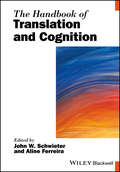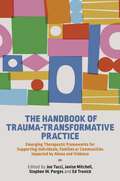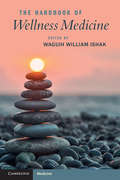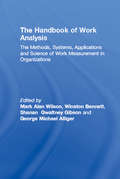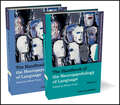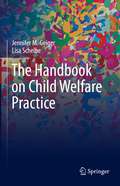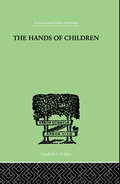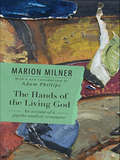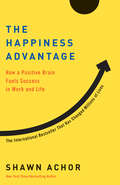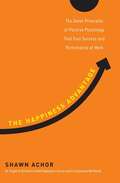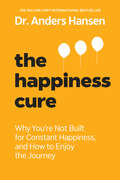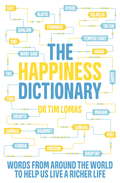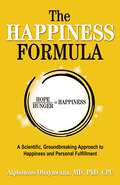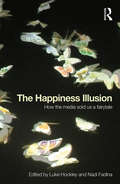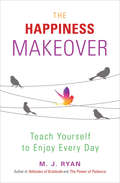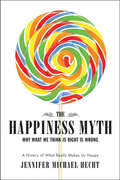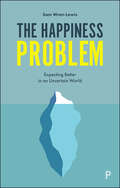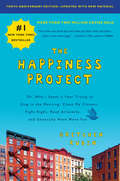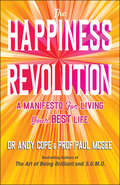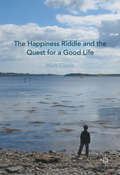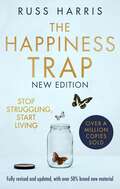- Table View
- List View
The Handbook of Translation and Cognition
by John W. Schwieter Aline FerreiraThe Handbook of Translation and Cognition is a pioneering, state-of-the-art investigation of cognitive approaches to translation and interpreting studies (TIS). Offers timely and cutting-edge coverage of the most important theoretical frameworks and methodological innovations Contains original contributions from a global group of leading researchers from 18 countries Explores topics related to translator and workplace characteristics including machine translation, creativity, ergonomic perspectives, and cognitive effort, and competence, training, and interpreting such as multimodal processing, neurocognitive optimization, process-oriented pedagogies, and conceptual change Maps out future directions for cognition and translation studies, as well as areas in need of more research within this dynamic field
The Handbook of Trauma-Transformative Practice: Emerging Therapeutic Frameworks for Supporting Individuals, Families or Communities Impacted by Abuse and Violence
by Maggie Kline Julian Ford Christine Courtois Paul Gilbert Jonathan Baylin Ruth Lanius Efrat Ginot Dan Hughes Noel Macnamara Deborah Lee Jennifer McIntosh Theresa Kestly Lou Cozolino Chloe Drulis Carly Samuelson C. Sue Carter Marcela Matos Breanne Kearney Judy Atkinson Margaret Hayes Carlie Atkinson Gerard Webster Gavin Morris Jessica Opie Anna Booth Kevin CreedenThe definitive Handbook of Trauma-Transformative Practice brings together the work of leading international trauma experts to provide a detailed overview of trauma-informed practice and intervention: its history, the latest frameworks for practice and an inspiring vision for future trauma-transformative practice.The Handbook is interdisciplinary, incorporating trauma research, interpersonal neuroscience, the historical and continuing experiences of victims and survivors, and insights from practitioners. It addresses a range of current issues spanning polyvagal theory, the social brain, oxytocin and the healing power of love, and the neuropsychological roots of shame. It also considers trauma through the lens of communities, with chapters on healing inter/transgenerational trauma and building communities' capacity to end interpersonal violence.Furthermore the Handbook makes the case for a new way of thinking about trauma - trauma transformative practice. One which is founded on the principle of working with the whole person and as part of a network of relationships, rather than focusing on symptoms to improve practice, healing and recovery.
The Handbook of Wellness Medicine
by Waguih William IsHakWellness medicine is the field that focuses on improving overall functioning, quality of life, and wellbeing, beyond symptom management of medical illness, leading to restoration and maintenance of health. The Handbook of Wellness Medicine provides a practical guide to the latest in evidence-based medicine, as well as best practice, to assist healthcare professionals in utilizing the full range of interventions to improve wellness and help patients complete their journeys to full health. The volume is organized into five parts: Part I introduces the concept of wellness by detailing the definitions and assessment/measurement methods, and formulating wellness plans. Part II describes wellness plans in major illnesses, categorized by organ system/disorder. Part III covers the methods to improve wellness in special populations. Part IV details each wellness intervention, including the scientific evidence behind it and its practical application. Part V focuses on integrating and personalizing the interventions into one's life to maintain wellness.
The Handbook of Work Analysis: Methods, Systems, Applications and Science of Work Measurement in Organizations (Applied Psychology Series)
by Winston Bennett Mark A. Wilson Shanan G. Gibson George M. Alliger Erich C. Dierdorff Suzanne Tsacoumis Robert J. Harvey Gregory M. HurtzThis new handbook, with contributions from experts around the world, is the most comprehensive treatise on work design and job analysis practice and research in over 20 years. The handbook, dedicated to Sidney Gael, is the next generation of Gael’s successful Job Analysis Handbook for Business, Industry and Government, published by Wiley in 1988. It consists of four parts: Methods, Systems, Applications and Research/Innovations. Finally, a tightly integrated, user-friendly handbook, of interest to students, practitioners and researchers in the field of Industrial Organizational Psychology and Human Resource Management. Sample Chapter available: Chapter 24, Training Needs Assessment by Eric A. Surface is available for download.
The Handbook of the Neuropsychology of Language (Blackwell Handbooks of Behavioral Neuroscience #12)
by Miriam FaustThis handbook provides a comprehensive review of new developments in the study of the relationship between the brain and language, from the perspectives of both basic research and clinical neuroscience. Includes contributions from an international team of leading figures in brain-language research Features a novel emphasis on state-of-the-art methodologies and their application to the central questions in the brain-language relationship Incorporates research on all parts of language, from syntax and semantics to spoken and written language Covers a wide range of issues, including basic level and high level linguistic functions, individual differences, and neurologically intact and different clinical populations
The Handbook on Child Welfare Practice
by Lisa Schelbe Jennifer M. GeigerThis unique, multidisciplinary resource incorporates cutting-edge research and best practices in child welfare into a text that aims to teach and refine advanced child welfare skills for aspiring child welfare professionals. Featuring real-life examples and stories from the field, the handbook discusses existing methods and challenges in the field of child welfare practice. Chapters also include materials for instructors to use in classrooms or training settings. Among the topics covered: Overview of child welfare policies and how the child welfare system worksAssessment tools and strategies used to identify various types of child abuse and neglect Individual, family, and community-level approaches to preventing child maltreatment and preserving families Promoting stability after foster care placement Effective collaboration while working with special populations Clinical supervision in child welfare practice Strategies for healthy professional development of child welfare practitioners The Handbook on Child Welfare Practice is a valuable resource as both a textbook in child welfare practice courses and a practical reference for child welfare professionals. This book will help develop a more knowledgeable and skilled child welfare workforce prepared to address the significant public health concern of child maltreatment.
The Handbook on Female Criminality in the Former Yugoslav Countries
by Elena Maksimova Angelina Stanojoska Darko DimovskiThis edited volume is the first volume that researches female criminality in the Balkan region and provides insights about patriarchal relations, gender roles, and female criminal behavior. The chapters provide research and data about crimes committed by females in Serbia, North Macedonia, Montenegro, Bosnia and Hercegovina, Croatia, and Slovenia. The chapters investigate topics such as: Long violence Social abuse and discrimination Life trajectories towards criminal behavior Women facing financial stress and dependence and how it relates to crime Women in the criminal justice system Examining the relationship between crime, gender, and the “modernization” of Balkan (ex-Yugoslavian) social structure, this volume is ideal for interdisciplinary criminology scholars specializing in the Balkans. Chapter 3 is available open access under a Creative Commons Attribution 4.0 International License via link.springer.com
The Hands Of Children: AN INTRODUCTION TO PSYCHO-CHIROLOGY (International Library Of Psychology Ser.)
by Julius SpierThis is Volume XVIII in a series of twenty-one in a collection on Individual Differences. Originally published in 1931, this posthumously published work provides the reader with an introduction to psych-chirology with additions by the current editor's experiments and anaylsis. With an Appendix on the Hands of the Mentally Diseased by Herta Levi.
The Hands of the Living God: An Account of a Psycho-analytic Treatment
by Marion MilnerAt once autobiographical and psychoanalytic, The Hands of the Living God, first published in 1969, provides a detailed case study of Susan who, during a 20-year long treatment, spontaneously discovers the capacity to do doodle drawings. An important focus of the book is the drawings themselves, 150 of which are reproduced in the text, and their deep unconscious perception of the battle between sanity and madness. It is these drawings, linked with Milner’s sensitive and lucid record of the therapeutic encounter, that give the book its unique and compelling interest. With a new introduction by Adam Phillips, The Hands of the Living God is essential reading for all those with an interest in the fields of psychoanalysis and psychotherapy and, more widely, to those involved in therapy and the arts.
The Handy Psychology Answer Book
by Lisa J CohenFeaturing more than 800 answers to questions of how the human mind and the science of psychology really work, this fascinating discussion gives readers the real facts of modern psychology in a fun, approachable way. Avoiding the entertainment fluff of pop psychology and the dryness of overly academic works, this exploration gives insight into the current science of the mind by answering questions questions such as What makes a marriage last? Why do toddlers have temper tantrums? and What are the benefits of getting older? In addition to the question-and-answer section, an overview looks at the psychology of money, sex, morality, and everyday living.
The Handy Psychology Answer Book
by Lisa J. CohenBridging the gap between the entertainment-focused "pop psychology” on television and the dry academic research that is published in journals, The Handy Psychology Answer Book helps answer why humans do what we do through accurate scientific data presented in a lively, accessible, and engaging way. It covers the fundamentals and explains the psychology behind how people deal with money, sex, morality, family, children, aging, addiction, work, and other everyday issues. Fully revised to reflect the latest scientific research--such as the current DSM-5 (Diagnostic and Statistical Manual of Mental Disorders, published by the American Psychiatric Association); the latest neurobiological theories; and the changing face of marriage--this timely reference has expanded to include information sections on the biology and evolution of emotions; technology and adolescence; bisexuality; optimism; autism; as well as a full section on the law, eyewitness testimony and police shootings. Featuring more than 1,500 answers to questions concerning how the human mind and the science of psychology really work such as: How have other cultures addressed psychological issues? Why was Freud so focused on sex? How can I maintain a healthy brain? Is it normal to argue during marriage? Does religion make people happier? How do we reduce social prejudice?
The Happiness Advantage: How a Positive Brain Fuels Success in Work and Life
by Shawn AchorOur most commonly held formula for success is broken. Conventional wisdom holds that if we work hard we will be more successful, and if we are more successful, then we'll be happy. If we can just find that great job, win that next promotion, lose those five pounds, happiness will follow. But recent discoveries in the field of positive psychology have shown that this formula is actually backward: Happiness fuels success, not the other way around. When we are positive, our brains become more engaged, creative, motivated, energetic, resilient, and productive at work. This isn't just an empty mantra. This discovery has been repeatedly borne out by rigorous research in psychology and neuroscience, management studies, and the bottom lines of organizations around the globe. In The Happiness Advantage, Shawn Achor, who spent over a decade living, researching, and lecturing at Harvard University, draws on his own research--including one of the largest studies of happiness and potential at Harvard and others at companies like UBS and KPMG--to fix this broken formula. Using stories and case studies from his work with thousands of Fortune 500 executives in 42 countries, Achor explains how we can reprogram our brains to become more positive in order to gain a competitive edge at work. Isolating seven practical, actionable principles that have been tried and tested everywhere from classrooms to boardrooms, stretching from Argentina to Zimbabwe, he shows us how we can capitalize on the Happiness Advantage to improve our performance and maximize our potential. Among the principles he outlines: * The Tetris Effect: how to retrain our brains to spot patterns of possibility, so we can see--and seize--opportunities wherever we look. * The Zorro Circle: how to channel our efforts on small, manageable goals, to gain the leverage to gradually conquer bigger and bigger ones. * Social Investment: how to reap the dividends of investing in one of the greatest predictors of success and happiness--our social support network A must-read for everyone trying to excel in a world of increasing workloads, stress, and negativity, The Happiness Advantage isn't only about how to become happier at work. It's about how to reap the benefits of a happier and more positive mind-set to achieve the extraordinary in our work and in our lives.From the Hardcover edition.
The Happiness Advantage: The Seven Principles of Positive Psychology that Fuel Success and Performance at Work
by Shawn Achor<p>Our most commonly held formula for success is broken. Conventional wisdom holds that if we work hard we will be more successful, and if we are more successful, then we’ll be happy. If we can just find that great job, win that next promotion, lose those five pounds, happiness will follow. But recent discoveries in the field of positive psychology have shown that this formula is actually backward: Happiness fuels success, not the other way around. When we are positive, our brains become more engaged, creative, motivated, energetic, resilient, and productive at work. This isn’t just an empty mantra. This discovery has been repeatedly borne out by rigorous research in psychology and neuroscience, management studies, and the bottom lines of organizations around the globe. <p>In The Happiness Advantage, Shawn Achor, who spent over a decade living, researching, and lecturing at Harvard University, draws on his own research—including one of the largest studies of happiness and potential at Harvard and others at companies like UBS and KPMG—to fix this broken formula. Using stories and case studies from his work with thousands of Fortune 500 executives in 42 countries, Achor explains how we can reprogram our brains to become more positive in order to gain a competitive edge at work. <p>Isolating seven practical, actionable principles that have been tried and tested everywhere from classrooms to boardrooms, stretching from Argentina to Zimbabwe, he shows us how we can capitalize on the Happiness Advantage to improve our performance and maximize our potential.</p>
The Happiness Cure: Why You're Not Built for Constant Happiness, and How to Enjoy the Journey
by Anders Hansen&“Anders Hansen&’s work is the antidote to our modern-day struggles.&”—Dr. Rangan Chatterjee, author of The Stress Solution Find long-term meaning and contentment in the journey of life with The Happiness Cure by internationally bestselling, award-winning psychiatrist and viral TEDx speaker Dr. Anders Hansen. As a species, we&’ve never had it so good. We&’re living longer and healthier lives than ever before; the sum of human knowledge and endless entertainment are only ever a few clicks away. So why are we in the midst of a mental health crisis? In The Happiness Cure, psychiatrist and well-being guru Dr. Anders Hansen presents a groundbreaking guide that explores the evolutionary roots of happiness and provides practical steps to help readers find true fulfillment. By combining cutting-edge neuroscientific research with relatable stories of ordinary individuals, Dr. Hansen offers a fresh perspective that challenges conventional thinking: the human brain isn&’t naturally wired for happiness. The Happiness Cure provides actionable strategies to navigate the complexities of modern life, finding joy along the way. With expertise and credibility, Dr. Anders Hansen empowers readers to take charge of their own happiness journey. Embark on a transformative path toward long-term contentment and discover the keys to a more fulfilling life. · Learn about the neural pathway hacks to contentment as you explore the intricate relationship between the human brain and happiness through the latest neuroscientific research and captivating real-life stories. · Gain inspiration from relatable stories of ordinary individuals who have applied the principles outlined in the book to their everyday lives. · Embrace a radical new approach to fulfillment utilizing the science of happiness, focusing on long-term contentment instead of short-term gratification. · Learn to better navigate the complexities of modern life and cultivate genuine happiness as you discover actionable strategies and practical steps. · Benefit from the wealth of knowledge and expertise of Dr. Anders Hansen, a respected psychiatrist and viral TEDx speaker, as he guides you toward a deeper understanding of how to be happy.
The Happiness Dictionary: Words from Around the World to Help Us Lead a Richer Life
by Dr Tim Lomas'A delightful compendium' - Evening StandardHave you ever had a feeling that you couldn't quite describe, because no English word exists for it?Indeed, without such a word, it's difficult to remember or understand the feeling, and to talk about it with other people. This applies to all aspects of life, but most of all that most sought-after of feelings, happiness, where our ability to both experience and understand it is limited by the words at our disposal. However, all is not lost. Even if English has not created a word for a specific feeling, another language probably has. These are known as 'untranslatable' words, because they lack an exact equivalent in another language. By discovering and learning these words, the boundaries of our world expand accordingly. These words allow us to give voice to feelings that we've probably experienced, but have previously lacked the ability to conceptualise. They may even allow us to encounter new feelings that we hadn't previously been aware of or enjoyed.This book will introduce you to a wealth of untranslatable words relating to happiness, from languages across the world. Reading it will enrich not just your understanding of happiness, but also the way that you experience it.
The Happiness Formula: A Scientific, Groundbreaking Approach to Happiness and Personal Fulfillment
by Alphonsus ObayuwanaA scientific, groundbreaking approach to happiness and personal fulfillment.In 1979, Dr. Alphonsus Obayuwana was awarded a national research grant and Smith-Kline Medical Perspective Fellowship to develop an instrument for measuring human hope, with the purpose of detecting hopelessness early enough in troubled human individuals so assistance could be offered in time to prevent suicide. The Hope Index Scale (HIS) that resulted from this grant became very popular with Fortune 500 companies and other institutions both in the US and in other countries. This led to the foundation of decades of research that ultimately resulted in this cutting-edge book, The Happiness Formula: Using Science to Understand Personal Satisfaction, Human Hope, and Subjective Well-Being. Unlike other books about happiness, which are too often filled with dos and don&’ts, wishful thinking, and empty aphorisms, The Happiness Formula breaks new ground by introducing a universal unit of measure called the &“Personal Happiness Index&” or PHI. This makes it possible—for the first time ever—to calculate and assign numerical happiness scores to human individuals by plugging their unique hopes, hungers, assets, and aspirations into an equation. Despite its title, The Happiness Formula is much more than a mathematical equation for measuring happiness. It is a book about life; the relationship between human hope and happiness; how to find, measure and boost them; and, most interestingly, how to confirm the happiest country in the world and even help identify the happiest living human, or HLH. It challenges the World Happiness Report of 2023, debunks three major happiness myths, and then introduces the Triple-H Equation—the simple but profound formula about what makes life worth living. This is a book for happiness seekers and happiness advocates everywhere.
The Happiness Illusion: How the media sold us a fairytale
by Luke Hockley Nadi FadinaThe West has never been more affluent yet the use of anti-depressants is on the increase to the extent that the World Health Organisation has declared it a major source of concern. How has this state of affairs come about and what can be done? Television and advertising media seem to know. Wherever we look they offer countless remedies for our current situation - unfortunately none of them seem to work. The Happiness Illusion explores how the metaphorical insights of fairy-tales have been literalised and turned into commodities. In so doing, their ability to educate and entertain has largely been lost. Instead advertising and television sell us products that offer to magically transform the way we look, how we age, where we live –both in the city and the countryside, the possibility of new jobs, and so forth. All of these are supposed to make us happy. But despite the allure of ‘retail therapy’ modern magic has lost its spell. What then are the sources of happiness in our contemporary society? Through a series of fairy-tales The Happiness Illusion: How the media sold us a fairytale looks at topics such as age, gender, marriage and rom-coms, Nordic Noir and the representations of therapy on television. In doing so it explores alternative ways to relate to the world in a symbolic and less literal manner – it suggests that happiness comes by making sure we don’t fall under the spell of the illusionary promises of contemporary television and advertising. Instead, happiness comes from being ourselves – warts and all. This book will be of interest to Jungian academics, film, media and cultural studies academics, social psychologists and their students, as well as reaching out to those interested in fairy-tale studies, psychotherapists and educated cinema goers. Luke Hockley PhD, is Research Professor of Media Analysis, at the University of Bedfordshire, UK. He is a practicing psychotherapist and is registered with the United Kingdom Council for Psychotherapy (UKCP). Luke is joint Editor in Chief of the International Journal of Jungian Studies (IJJS) and a member of the Advisory Board for the journal Spring and lectures widely. www.lukehockley.com Nadi Fadina is a media entrepreneur and a managing partner in an international film fund. She is involved in a variety of arts and media related projects, both in profit and non-profit spheres. She teaches Film Business in the University of Bedfordshire, however, her academic interests outreach spheres of business and cover ideology, Russian fairytales, sexuality, politics, anthropology, and cinema. www. nadi-fadina.com
The Happiness Makeover: Overcome Stress and Negativity to Become a Hopeful, Happy Person
by M. J. RyanBecome a Happy Person Through Positivity and Self-Care“A wonderful blend of motivation, inspiration, and explanation, The Happiness Makeover is a recipe for enjoying today and all your tomorrows.” —David Niven, PhD, author of The 100 Simple Secrets of Happy PeopleFrom M.J. Ryan, one of the creators of the New York Times bestselling Random Acts of Kindness series, The Happiness Makeover teaches you how to be a happy person and enjoy the experience of life again.Train your brain to be optimistic, even in the darkest situations. From stress management tips to positive and motivational quotes, M.J. Ryan’s positivity book shows you how to transform your mindset so that you can face any difficult challenge thrown your way.We all want the things that we are sure will make us a happy person —money, success, independence, and love. But when we finally get them, we can find to our surprise that we are the same miserable, moody, or unhappy person we always were. Do things have to be that way? Absolutely not!Cultivating the ability to feel contentment is the key. There are people whose lives are full of serious challenges who nevertheless feel peace and joy —and there are those who have few difficulties in life and yet feel hopeless negativity. You can teach yourself to be a happy person and enjoy your days. M.J. Ryan, the bestselling author of The Power of Patience and Attitudes of Gratitude, shows you how in this positive thinking guide. The Happiness Makeover gives you a plan that can help you:Clear away happiness hindrances like worry, fear, envy, and grudgesDiscover happiness boosters with gratitude and hopeRewire your brain to experience joyLearn to think optimistically and be a happy personIf you enjoyed optimism books and positivity books like A Year of Positive Thinking, The Happiness Trap, or Habits of a Happy Brain, then you’ll love The Happiness Makeover.
The Happiness Makeover: Teach Yourself to Enjoy Every Day
by M. J. RyanTrain your brain to be more optimistic: &“This book is like happy electricity—connecting us all to our joy, which we continually forget how to access.&”—SARK, author/artist of Make Your Creative Dreams Real We all want the things that we&’re sure will make us happy—money, success, independence, love. But when we finally get them, we can find to our surprise that we are the same miserable, moody, or just neutral people we always were. Is that just the way things are? Luckily, no! There are people whose lives are full of serious challenges but who nevertheless feel peace and joy—and there are those who have few difficulties in life and yet feel hopeless. Cultivating the ability to feel contentment is the key. We can teach ourselves to be happy and enjoy every day, and M.J. Ryan, bestselling author of The Power of Patience and Attitudes of Gratitude, shows us how. The Happiness Makeover presents a plan that can help you: · clear away happiness hindrances like worry, fear, envy, and grudges · discover happiness boosters · rewire your brain to experience contentment—even joy · learn to think optimistically (It really is possible!)
The Happiness Myth: Why What We Think Is Right Is Wrong
by Jennifer Hecht“Among the raft of happiness books published lately, this one is the obvious standout. I suggest climbing aboard.” —Cleveland Plain DealerIn this “eclectic and entertaining” book (Publishers Weekly), Jennifer Michael Hecht explodes myths both ancient and modern about how to be happy—liberating us from the message that there’s only one way to care for our hearts, minds, and bodies. The result is “a provocative, well-researched cultural history that will certainly make readers rethink their assumptions about what constitutes happiness” (Library Journal).“Hecht’s curiosity ranges widely, and the breadth of her learning is impressive . . . Fresh and daring analysis.” —The Washington Post“Deep and thoughtful.” —Scientific American“Exposing the half-baked fads of the present by illuminating the even less baked ones of the past can be a lot of fun, and Hecht, a historian and poet, entertains us with some classics.” —The New York Times“A pleasure not only to read but also to ponder.” —Booklist
The Happiness Problem: Expecting Better in an Uncertain World
by Sam Wren-LewisWe appear to have more control over our lives than ever before. If we could get things right – the perfect job, relationship, family, body and mind – then we’d be happy. With enough economic growth and technological innovation, we could cure all societal ills. The Happiness Problem shows that this way of thinking is too simplistic and can even be harmful: no matter how much progress we make, we will still be vulnerable to disappointment, loss and suffering. The things we do to make ourselves happy are merely the tip of the iceberg. Sam Wren-Lewis offers an alternative process that acknowledges insecurity and embraces uncertainty. Drawing on our psychological capacities for curiosity and compassion, he proposes that we can connect with, and gain a deeper understanding of, the personal and social challenges that define our time
The Happiness Project, Tenth Anniversary Edition: Or, Why I Spent a Year Trying to Sing in the Morning, Clean My Closets, Fight Right, Read Aristotle, and Generally Have More Fun
by Gretchen Rubin#1 New York Times Bestseller“An enlightening, laugh-aloud read. . . . Filled with open, honest glimpses into [Rubin’s] real life, woven together with constant doses of humor.”—Christian Science MonitorGretchen Rubin’s year-long experiment to discover how to create true happiness. Drawing on cutting-edge science, classical philosophy, and real-world examples, Rubin delivers an engaging, eminently relatable chronicle of transformation. This special 10th Anniversary edition features a Conversation with Gretchen Rubin, Happiness Project Stories, a guide to creating your own happiness project, a list of dozens of free resources, and more.Gretchen Rubin had an epiphany one rainy afternoon in the unlikeliest of places: a city bus. “The days are long, but the years are short,” she realized. “Time is passing, and I’m not focusing enough on the things that really matter.” In that moment, she decided to dedicate a year to her happiness project.In this lively and compelling account—now updated with new material by the author—Rubin chronicles her adventures during the twelve months she spent test-driving the wisdom of the ages, current scientific research, and lessons from popular culture about how to be happier. Among other things, she found that novelty and challenge are powerful sources of happiness; that money can help buy happiness, when spent wisely; that outer order contributes to inner calm; and that the very smallest of changes can make the biggest difference.This updated edition includes:An extensive new interview with the authorStories of other people’s life-changing happiness projectsA resource guide to the dozens of free resources created for readersThe Happiness Project ManifestoAn excerpt from Rubin’s bestselling book The Four Tendencies: The Indispensable Personality Profiles that Reveal How to Make Your Life Better (and Other People’s Lives Better, Too)
The Happiness Revolution: A Manifesto for Living Your Best Life
by Andy Cope Paul McGeeA new book by two of the biggest powerhouses in positive psychology and personal development – Dr Andy Cope and Professor Paul McGee Happiness. We chase it, we crave it…it’s so in demand… yet so scarce and fleeting. But here’s the good news. In The Happiness Revolution: A Manifesto For Living Your Best Life, bestselling authors Dr Andy Cope and Professor Paul McGee deliver a page-turning self-help book of the times, for the times. As the world wakes up to a new kind of normal, The Happiness Revolution challenges readers to sign up to an uprising of wellbeing and to making the most of the privilege of being on this planet. The book outlines a 10-point Happiness Manifesto. Grounded in the science of human flourishing and the reality of life, the principles are simple, do-able and above all make a difference not only to yourself but to others too. Let the fight back to mental wealth start right here. Welcome to global domination of the happiness kind! Discover: How to regain your sanity, clarity, and wellbeing, even when your smartphone, kids, spouse, job, and possessions seem to be conspiring to keep you from doing just that. Why it can be so hard to maintain a happy outlook when the outside world has never been so fast, complex, and unpredictable. How to be at your best in a world that is doing its worst. Happiness is the #1 thing you want for yourself and your family. The Happiness Revolution is an indispensable guide for everyone trying to live their best life and to spread some happiness whilst doing so. Rise Up and Be Happy! Vive la revolution!
The Happiness Riddle and the Quest for a Good Life
by Mark CieslikThis book examines the meaning of happiness in Britain today, and observes that although we face challenges such as austerity, climate change and disenchantment with politics, we continue to be interested in happiness and living well. The author illustrates how happiness is a far more contested, social process than is often portrayed by economists and psychologists, and takes issue with sociologists who often regard wellbeing and the happiness industry with suspicion, whilst neglecting one of the key features of being human – the quest for a good life. Exploring themes that question what it means to be happy and live a good life in Britain today, such as the challenges young people face making their way through education and into their first jobs; work life-balance; mid-life crises; and old age, the book presents nineteen life stories that call for a far more critical and ambitious approach to happiness research that marries the radicalism of sociology, with recent advances in psychology and economics. This book will appeal to students and academics interested in wellbeing, happiness and quality of life and also those researching areas such as the life course, work-life balance, biographies, aging and youth studies.
The Happiness Trap 2nd Edition: Stop Struggling, Start Living
by Russ HarrisTHE MILLION-COPY BESTSELLERDo you ever feel worried, miserable or unfulfilled - yet put on a happy face and pretend everything's fine? You are not alone. Stress, anxiety, depression and low self-esteem are all around. Research suggests that many of us get caught in a psychological trap, a vicious circle in which the more we strive for happiness, the more it eludes us.Fortunately, there is a way to escape from the 'Happiness Trap' in this updated and expanded second edition which unlocks the secrets to a truly fulfilling life. This empowering book presents the insights and techniques of Acceptance and Commitment Therapy (ACT), covering more topics and providing more practical tools than ever before. Learn how to clarify your values, develop self-compassion and find true satisfaction with this bigger and better guide to:· Reducing stress and worry· Handling painful thoughts and feelings more effectively· Breaking self-defeating habits· Overcoming insecurity and self-doubt· Building better relationships· Improving performance and finding fulfilment at workThe Happiness Trap is for everyone. Whether you're lacking confidence, facing illness, coping with loss, working in a high-stress job, or suffering from anxiety or depression, this book will show you how to build authentic happiness, from the inside out.
